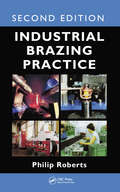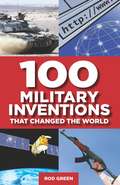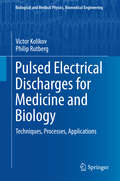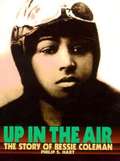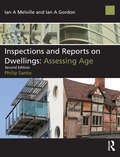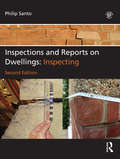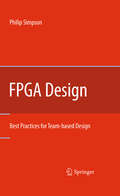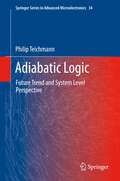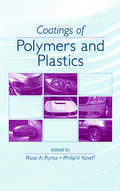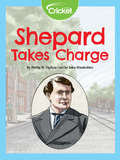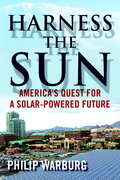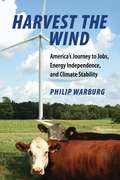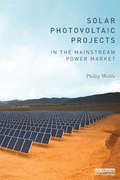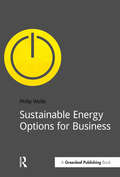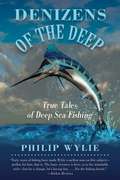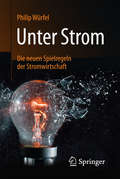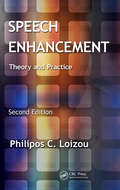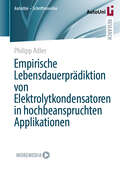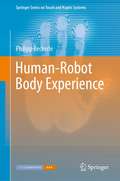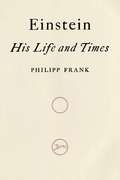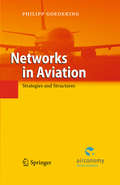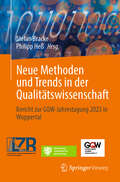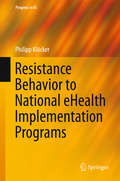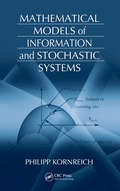- Table View
- List View
Industrial Brazing Practice
by Philip RobertsIn the past ten years, brazing technology has undergone sweeping changes. Yet because there are so few practitioners who understand the finer points of the technology, many of the companies that use brazing as their preferred metal-joining procedure are failing to use it to best effect. Fully updated to reflect the latest practices, this second edi
100 Military Inventions that Changed the World: That Changed The World
by Philip RussellNothing ensures the rapid development of new technology like the involvement of the military. From the trebuchet and the cannon to the tank and the ballistic missile, military research programmes have produced the most devastating weapons imaginable, but military masterminds are responsible for a number of surprises along the way as well.Radar, walkie-talkies and the jet engine are more obvious examples of military inventions that are now in everyday use around the world, but there are plenty of items with which all of us come into contact on a daily basis that have been developed from military technology. Rod Green describes how the microwave oven in your kitchen, the sat-nav in your car or the Internet that you use every day all owe their existence to the military as he takes us on a highly entertaining voyage of discovery through the world of military inventions ancient and modern.
Pulsed Electrical Discharges for Medicine and Biology
by Victor Kolikov Philip RutbergThis book presents the application of pulsed electrical discharges in water and water dispersions of metal nanoparticles in medicine (surgery, dentistry, and oncology), biology and ecology. The intensive electrical and shock waves represent a novel technique to destroy viruses and this way to prepare anti-virus vaccines. The method of pulsed electrical discharges in water allows to decontaminate water from almost all known bacteria and spores of fungi being present in human beings. The nanoparticles used are not genotoxic and mutagenic. This book is useful for researchers and graduate students.
Up in the Air: The Story of Bessie Coleman
by Philip S. HartPresents the story of Bessie Coleman, an American, who in 1920 traveled to France to become the first black woman to earn a pilot's license.
Inspections and Reports on Dwellings: Assessing Age
by Philip SantoIdentifying the age of a property is a fundamental step in understanding its form of construction and in being prepared to differentiate between the characteristic defects of that age of property and defects which are more unusual and may warrant particular care in investigation and assessment. This second edition of Inspections and Reports on Dwellings: Assessing Age updates the market context within which surveyors and valuers are now operating. In particular it has a new section on post-2000 properties, reflecting the profound impact of Government policies and environmental concerns on the modern urban landscape. The book is divided into thirteen age bands with over seventy color photographs of dwellings for each period. A commentary on each age band outlines the social, environmental and technical influences on properties being built at the time, helping to explain why they look as they do. A broad range of dwellings is covered: large and small, private and public sector, old and new, and particular features which help to place a dwelling within one of the defined periods are highlighted in comments on the photographs. This book is intended for all those engaged in inspecting dwellings, whether experienced, newly qualified or studying for appropriate qualifications to become members of professional institutions.
Inspections and Reports on Dwellings: Inspecting
by Philip SantoInspections and Reports on Dwellings is a three-volume series that comprehensively explores the process of independent professional home assessment required for the purchase of residential property. This fully updated second edition of Inspecting retains a focus on the needs of the surveyor to recognise and interpret the significance of observations on site, whilst updating the market context within which surveyors and valuers are operating. Inspecting includes a consideration of the important benchmarking by the Royal Institution of Chartered Surveyors (RICS) of three distinct survey service levels for independent surveyors and a review of the wider choice of survey options professional surveyors can now offer to potential clients in addition to the RICS Home Survey range. There is additional content on preparing for the inspection and on reporting, and there are expanded or completely new sections on a variety of subjects such as conservatories, renewable energy technologies, and innovative techniques and forms of construction. With over 500 colour illustrations and an enhanced structure, the new edition reflects the very latest approach to inspecting and reporting on services, risk and legal matters. This book is essential reading for all those engaged in inspecting dwellings, whether experienced, newly qualified or studying for appropriate qualifications to become members of professional institutions.
FPGA Design: Best Practices for Team-based Design
by Philip SimpsonThis book describes best practices for successful FPGA design. It is the result of the author's meetings with hundreds of customers on the challenges facing each of their FPGA design teams. By gaining an understanding into their design environments, processes, what works and what does not work, key areas of concern in implementing system designs have been identified and a recommended design methodology to overcome these challenges has been developed. This book's content has a strong focus on design teams that are spread across sites. The goal being to increase the productivity of FPGA design teams by establishing a common methodology across design teams; enabling the exchange of design blocks across teams. overage includes the complete FPGA design flow, from the basics to advanced techniques.
An American Hero: An Authorized Biography
by Philip SingermanAn American Hero: The RedAdair Story. Back in the days of the great Texas oil fields when fortunes were made and lost overnight, they said derricks were built out of wood but the men were carved from steel. Red Adair is such a man. A genuine American hero, this daredevil firefighter has been combating the most terrifying force of nature all over the world for more than fifty years. Red has braved gas and oil-well fires that send walls of flame hundreds of feet in the air, fires so hot they melt nearby trucks fires that can roast a man. From the wild and free-spirited days in the Texas oil patches to scenes of front line fire battles in Malaya and Algeria, Red tells how and why he repeatedly risked his own life challenging some of the worst disasters of modern times. -
Adiabatic Logic: Future Trend and System Level Perspective (Springer Series in Advanced Microelectronics #34)
by Philip TeichmannAdiabatic logic is a potential successor for static CMOS circuit design when it comes to ultra-low-power energy consumption. Future development like the evolutionary shrinking of the minimum feature size as well as revolutionary novel transistor concepts will change the gate level savings gained by adiabatic logic. In addition, the impact of worsening degradation effects has to be considered in the design of adiabatic circuits. The impact of the technology trends on the figures of merit of adiabatic logic, energy saving potential and optimum operating frequency, are investigated, as well as degradation related issues. Adiabatic logic benefits from future devices, is not susceptible to Hot Carrier Injection, and shows less impact of Bias Temperature Instability than static CMOS circuits. Major interest also lies on the efficient generation of the applied power-clock signal. This oscillating power supply can be used to save energy in short idle times by disconnecting circuits. An efficient way to generate the power-clock is by means of the synchronous 2N2P LC oscillator, which is also robust with respect to pattern-induced capacitive variations. An easy to implement but powerful power-clock gating supplement is proposed by gating the synchronization signals. Diverse implementations to shut down the system are presented and rated for their applicability and other aspects like energy reduction capability and data retention. Advantageous usage of adiabatic logic requires compact and efficient arithmetic structures. A broad variety of adder structures and a Coordinate Rotation Digital Computer are compared and rated according to energy consumption and area usage, and the resulting energy saving potential against static CMOS proves the ultra-low-power capability of adiabatic logic. In the end, a new circuit topology has to compete with static CMOS also in productivity. On a 130nm test chip, a large scale test vehicle containing an FIR filter was implemented in adiabatic logic, utilizing a standard, library-based design flow, fabricated, measured and compared to simulations of a static CMOS counterpart, with measured saving factors compliant to the values gained by simulation. This leads to the conclusion that adiabatic logic is ready for productive design due to compatibility not only to CMOS technology, but also to electronic design automation (EDA) tools developed for static CMOS system design.
Coatings Of Polymers And Plastics
by Rose A. Ryntz Philip V. YaneffSurveying developments in coating polymers and plastics, this book examines proper materials selection, basic processing mechanics, process selection based on cost and coating mechanics, molding, and performance and durability assessments. This text is a reference tailored for busy professionals or students in coatings courses. It highlights techniques for salvaging plastics from used vehicles, including the recycling of automotive plastics, and compares North American and European techniques for coating plastics in the automotive industry.
Shepard Takes Charge
by Philip W. OgilvieMove America's capital to another city? To Alexander Robey Shepherd, the solution to Washington, DC's problems was clear: modernization. Shepherd took on the monumental task of improving roadways and drinking water, adding street gaslights, and planting trees.
Harness the Sun
by Philip WarburgGoing from the inner city to the open desert, a seasoned environmental advocate looks at solar energy's remarkable ascent and its promise for America's future Solar power was once the domain of futurists and environmentally minded suburbanites. Today it is part of mainstream America. Scan the skyline of downtown neighborhoods, check out the rooftop of the nearest Walmart, and take a close look at your local sports arena. Chances are you'll find solar panels in those and many other unexpected places. In Harness the Sun, Philip Warburg takes readers on a far-flung journey that explores America's solar revolution. Beginning with his solar-powered home in New England, he introduces readers to the pioneers who are spearheading our move toward a clean energy economy. We meet the CEOs who are propelling solar power to prominence and the intrepid construction workers who scale our rooftops installing panels. We encounter the engineers who are building giant utility-scale projects in prime solar states like Nevada, Arizona, and California, and the biologists who make sure wildlife is protected at those sites. Warburg shows how solar energy has won surprising support across the political spectrum. Prominent conservatives embrace solar power as an emblem of market freedom, while environmental advocates see it as a way to reduce America's greenhouse gas emissions. At the same time, economic-justice activists celebrate solar's potential to lift up low-income communities, and Native American leaders welcome the income and jobs that the industry will bring to their communities. Yet solar energy has its downsides and detractors too. Conservationists worry about the impact of large solar farms on protected animal species, and some local citizens groups resent the encroachment of solar projects on farmland and open spaces. Warburg gives voice to those at the epicenter of these conflicts and points the way to constructive solutions. Harness the Sun offers a grounded, persuasive vision of America's energy future. It is a future fueled by clean, renewable sources of power, with solar at center stage.
Harvest the Wind: America's Journey to Jobs, Energy Independence, and Climate Stability
by Philip WarburgWinds sweeping across the Great Plains once robbed the Farm Belt of its future, stripping away overworked topsoil and creating the dreaded Dust Bowl of the 1930s. Today, those winds are bringing new hope to the declining rural communities of the central United States. Nowhere is wind's promise more palpable than in Cloud County, Kansas, home to the Meridian Way Wind Farm, whose turbines are boosting farm incomes and bringing green jobs to a community that has watched its children flock elsewhere. Modern wind power is the best thing to hit this stretch of midwestern prairie since the Union Pacific railroad.In Harvest the Wind, Warburg brings us the people behind the green economy-powered resurgence in Cloud County and communities like it across the United States. This corner of Kansas is the first stop on an odyssey that introduces readers to farmers, factory workers, biologists, and high-tech entrepreneurs--all players in a transformative industry that is taking hold across America and around the globe.Harvest the Wind serves as an earthly antidote to the more abstract treatises on global warming and green energy. By showing us how practical solutions are being implemented at the local level, Warburg offers an inspirational look at how we can all pursue a saner and more sustainable energy future.
Solar Photovoltaic Projects in the Mainstream Power Market
by Philip WolfeThis is the first and probably the only book devoted to utility-scale solar power – perhaps the fastest-growing sector of the global energy market. Philip Wolfe’s book describes the development and operation of large-scale solar power stations, and will interest all those who want to understand how these multi-million dollar projects are designed, structured, financed, constructed and maintained. It contains case studies of the Waldpolenz Energy Park, Germany, Lopburi Solar Plant in Thailand and the Topaz Solar Farm in California. Also included are interviews from leading figures in the PV industry. It shows the state of the world market and links to an online resource that continues to track the explosive growth of the sector. The book is arranged in three sections: A description of solar projects in context, and how they are undertaken. Chapters on developing and structuring projects; siting, consenting and connection issues; building and operating solar plants; design and technology basics; economies of solar photovoltaics. The second section reviews individual aspects of the project development and operational process in more detail. In particular it advises on strategies to manage technology, commercial, regulatory and implementation risks. These are supported by a comprehensive reference section, including case studies and overviews of key parameters applicable in different parts of the world. Supported by figures and photographs, this book is for anyone wanting to master the commercial, professional, financial, engineering or political aspects of developing multi-mega-watt solar PV projects in a mainstream power market. It is a ‘user manual’ to accompany a sector which by 2015 had surpassed a value of $100 billion.
Sustainable Energy Options for Business (Doshorts Ser.)
by Philip WolfeThe major environmental impact of most businesses derives from energy usage. The upside of this is that using energy more responsibly improves profitability. A business’s cheapest unit of energy is also the one which is least damaging to the planet: the unit you don't use.There are many ways to make your organization's energy usage more sustainable. In Sustainable Energy Options for Business, Philip Wolfe outlines the best available options for (1) reducing energy use and (2) improving the sustainability of energy supply. After an introduction to regulatory drivers and management issues, Wolfe looks at energy opportunities in five key areas: 1. Saving on energy usage; 2. Finding more sustainable sources of energy; 3. Generating renewable electricity; 4. Producing renewable heat; 5. Indirect energy sustainability options.Also included: An "energy checklist" to help identify your best options and important quick wins, plus a handy reference list, signposted from annotations in the text.
Denizens of the Deep: True Tales of Deep Sea Fishing
by Philip WylieA Collection of Stories about Fish, Fishermen, and Favorite Fishing Spots with Action on Every Page The incomparable Philip Wylie is here writing about one of the things he likes best--fishing. Anyone who has ever wet a line, and perhaps those few benighted souls who haven’t, will be thrilled to read these true tales about the big ones, hooked (and sometimes lost) in tropic waters. In Denizens of the Deep, which was originally published in 1947, there are wonderful chapters on marlin, the "admirable” barracuda, and the shark, whom Wylie calls "that misunderstood fish. ” The bursting pride when you catch that first big one is recaptured with fine nostalgia in the essay "What Makes a Great Day’s Fishing?” and the tragedy of the clean getaway in "Listen to This Tale of Woe. ” Serious fishermen with an interest in the pastime’s history will also find much valuable information in the chapter on the International Game Fish Association.
Unter Strom
by Philip WürfelSpätestens seit der Reaktorkatastrophe von Fukushima ist das Thema Energiewende als generationsübergreifendes Projekt in der breiten Öffentlichkeit angekommen. Dabei reichen die Wurzeln der Energiewende viel weiter zurück. Wer aber kann von sich behaupten, wirklich zu verstehen, worum es jenseits der oberflächlich geführten Pro-Contra-Debatten geht? Die Mechanismen unserer Stromversorgung sind komplex, und populistische Forderungen von Lobbyverbänden erschweren häufig die objektive Meinungsbildung.Philip Würfel bringt mit diesem Buch Licht ins Dunkel. Anschaulich erklärt er die komplexen Zusammenhänge der Energiewirtschaft und vermittelt den revolutionären, auch im Ausland viel diskutierten Umbauprozess der Stromversorgung in Deutschland. Zahlreiche Beispiele aus dem privaten wie beruflichen Alltag bescheren immer wieder „Aha“-Erlebnisse beim Lesen. Die überarbeitete und aktualisierte 2. Auflage ergänzt die 1. Auflage um die sich abzeichnenden Megatrends der Elektromobilität und des Pariser Klimaabkommens.
SPEECH ENHANCEMENT: Theory And Practice
by Philipos C. LoizouWith the proliferation of mobile devices and hearing devices, including hearing aids and cochlear implants, there is a growing and pressing need to design algorithms that can improve speech intelligibility without sacrificing quality. Responding to this need, Speech Enhancement: Theory and Practice, Second Edition introduces readers to the basic problems of speech enhancement and the various algorithms proposed to solve these problems. Updated and expanded, this second edition of the bestselling textbook broadens its scope to include evaluation measures and enhancement algorithms aimed at improving speech intelligibility. Fundamentals, Algorithms, Evaluation, and Future Steps Organized into four parts, the book begins with a review of the fundamentals needed to understand and design better speech enhancement algorithms. The second part describes all the major enhancement algorithms and, because these require an estimate of the noise spectrum, also covers noise estimation algorithms. The third part of the book looks at the measures used to assess the performance, in terms of speech quality and intelligibility, of speech enhancement methods. It also evaluates and compares several of the algorithms. The fourth part presents binary mask algorithms for improving speech intelligibility under ideal conditions. In addition, it suggests steps that can be taken to realize the full potential of these algorithms under realistic conditions.
Empirische Lebensdauerprädiktion von Elektrolytkondensatoren in hochbeanspruchten Applikationen (AutoUni – Schriftenreihe #174)
by Philipp AdlerPhilipp Adler zeigt eine verbesserte Lebensdauerprädiktion von Elektrolytkondensatoren in Elektrofahrzeugen durch die Analyse temperaturbedingter Einflüsse mittels Multi-Domänen-Simulationen. Dies steigert die Systemzuverlässigkeit über 15 Jahre. Ein neu entwickeltes empirisches Modell erlaubt präzisere Alterungsprognosen. Langzeitversuche bestätigen, dass eine verbesserte thermische Anbindung mittels Wärmeleitpaste entscheidend die Lebensdauer erhöht. Die Ergebnisse fördern die Entwicklung langlebiger Elektrofahrzeuge und die EMV-Konformität.
Human-Robot Body Experience (Springer Series on Touch and Haptic Systems)
by Philipp BeckerleThis monograph presents innovative research regarding the body experience of human individuals who are using assistive robotic devices such as wearable robots or teleoperation systems. The focus is set on human-in-the-loop experiments that help to empirically evaluate how users experience devices. Moreover, these experiments allow for further examination of the underlying mechanisms of body experience through extending existing psychological paradigms, e.g., by disentangling tactile feedback from contacts. Besides reporting and discussing psychological examinations, the influence of various aspects of engineering design is investigated, e.g., different implementations of haptic interfaces or robot control. As haptics are of paramount importance in this tight type of human-robot interaction, it is explored with respect to modality as well as temporal and spatial effects. The first part of the book motivates the research topic and gives an in-depth analysis of the experimental requirements. The second and third part present experimental designs and studies of human-robot body experience regarding the upper and lower limbs as well as cognitive models to predict them. The fourth part discusses a multitude of design considerations and provides directions to guide future research on bidirectional human-machine interfaces and non-functional haptic feedback.
Einstein
by Philipp FrankMuch has been written about Albert Einstein, technical and biographical, but very little remains as valuable as this unique hybrid of a book written by Einstein’s colleague and contemporary. Both rich in personal insights and grounded in a deep knowledge of twentieth-century science, Phillip Frank's biography anchors the reader with a lucid overview of physics and draws an intimate portrait of the Nobel Prize-winner.
Networks in Aviation: Strategies and Structures
by Philipp GoedekingAviation networks play a critical role in the success of today's airlines and airports. This book provides insight on all aspects of modern network strategies and structures, ranging from market research to hub design, operations, organization, alliances, benchmarking, and antitrust issues. Considering both the airline and the airport perspectives, the book explains the economics of connectivity or productivity-driven hub structures through basic mathematics, which helps the reader to comprehend the structural strengths and weaknesses of aviation networks. More than 100 charts help clarify the topics at hand.
Neue Methoden und Trends in der Qualitätswissenschaft: Bericht zur GQW-Jahrestagung 2023 in Wuppertal
by Stefan Bracke Philipp HeßZielsetzung der Gesellschaft für Qualitätswissenschaft e.V. ist es, die Qualitätswissenschaft in Lehre und Forschung zu fördern und den Wissenstransfer in die industrielle Anwendung zu unterstützen. Dies erfolgt unter anderem durch Pflege des wissenschaftlichen Erfahrungsaustauschs unter den auf diesem Gebiet tätigen Personen und Institutionen und der Verbreitung von Forschungs- und Entwicklungsergebnissen sowie der Unterstützung des Wissenstransfers zwischen Forschung und Praxis. Die Entwicklung von technisch komplexen Produkten, Prozessen sowie neuen Dienstleistungen erfolgt auf Basis stetig expandierender Wertschöpfungsnetzwerke in einem turbulenten Marktumfeld. Anforderungen von Kunden und Märkten an Funktionalität, Zuverlässigkeit und Sicherheit nehmen zu, wobei die Wertschöpfung auf viele Kooperationspartner verteilt wird und deren Vernetzung im nationalen und internationalen Kontext stetig ansteigt. Des Weiteren führt die zunehmende Digitalisierung von Produkten und Unternehmensprozessen dazu, dass die Verfügbarkeit von Entwicklungsdaten, Produktionsprozessdaten sowie Betriebsdaten zu einem exponentiellen Daten- und Informationsvolumen führt. Dies stellt gleichermaßen Herausforderung und Potential für die Qualitätswissenschaften dar. Unter dem Leitthema „Neue Methoden und Trends in der Qualitätswissenschaft“ hat die Gesellschaft für Qualitätsmanagement gemeinsam mit der Bergischen Universität Wuppertal zur GQW Tagung 2023 eingeladen. Wir freuen uns, dass wir Ihnen nun den zugehörigen Tagungsband vorstellen können.
Resistance Behavior to National eHealth Implementation Programs
by Philipp KlöckerThis monograph discusses challenges faced during the implementation of national eHealth programs. In particular, it analyzes the causes of stakeholders' reluctance to adopt these technologies by drawing on user resistance theory and context specific variables. Taking the example of the introduction of the electronic health card (Elektronische Gesundheitskarte - eGK) technology in Germany, the book presents insights into why these programs are often lengthy, costly and have previously been met with fierce resistance from key stakeholders. It also presents a quantitative and qualitative study of individual physicians' resistance behavior towards these new eHealth technologies.
Mathematical Models of Information and Stochastic Systems
by Philipp KornreichFrom ancient soothsayers and astrologists to today’s pollsters and economists, probability theory has long been used to predict the future on the basis of past and present knowledge. Mathematical Models of Information and Stochastic Systems shows that the amount of knowledge about a system plays an important role in the mathematical models used to foretell the future of the system. It explains how this known quantity of information is used to derive a system’s probabilistic properties. After an introduction, the book presents several basic principles that are employed in the remainder of the text to develop useful examples of probability theory. It examines both discrete and continuous distribution functions and random variables, followed by a chapter on the average values, correlations, and covariances of functions of variables as well as the probabilistic mathematical model of quantum mechanics. The author then explores the concepts of randomness and entropy and derives various discrete probabilities and continuous probability density functions from what is known about a particular stochastic system. The final chapters discuss information of discrete and continuous systems, time-dependent stochastic processes, data analysis, and chaotic systems and fractals. By building a range of probability distributions based on prior knowledge of the problem, this classroom-tested text illustrates how to predict the behavior of diverse systems. A solutions manual is available for qualifying instructors.
